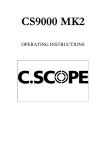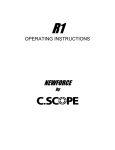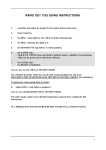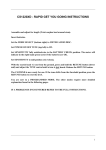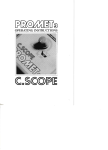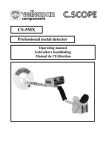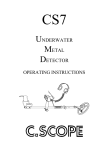Download C-SCOPE CS8SST Operating instructions
Transcript
CS8SST OPERATING INSTRUCTIONS 2 CS 8 SST - RAPID GET YOU GOING INSTRUCTIONS SET-UP Assemble and adjust for length (Twist surplus lead around stem). 2 3 Insert batteries. Set the controls on the front panel as follows: • NOTCH (SELECT) Fully anti-clockwise • NOTCH (WIDTH) Fully anti-clockwise • DISC 9 o'clock • POWER 3 o'clock. (This switches the unit on. The right hand LED on the front panel will illuminate for about one second indicating charged batteries.) SEARCHING Keep the search head at a constant height, i.e. do not allow the head to swing higher above the ground at the right and left edges of your swing. PINPOINTING When you hear a tone from the loudspeaker, you have found a target. • Keep the head close to the ground & move it away from the target. • Hold the PINPOINT push-button. • Sweep the head over the target area. • The sound will be loudest when the head is directly above the target. THE DISCRIMINATE (DISC) CONTROL Use to ignore metal in the following order as you turn the knob clockwise: Iron, Silver Paper (Aluminium foil), new 10p, old 10p, Bottle Cap, £1 coin. THE NOTCH CONTROLS Can be set to selectively ignore only certain targets, however, please refer to the full instructions to use this facility. IF A PROBLEM IS ENCOUNTERED REFER TO THE FULL INSTRUCTIONS 3 4 CS 8SST A B A B C D E F G Battery Compartment Upper Stem & Handle Grips Din Plug & Socket Stem Connecting Nut Cable Lower Stem Search Head & Fastener C D E F G 4 5 FEATURES • • • • • • • • • • • • Computerised control system SST intelligent ground tracking Smart Scan panel array High speed target analyser Target Pin-point Depth reading Overdrive large target indication Anti dust & moisture features Comfortable balance 8 inch diameter, lightweight search head 12.5KHz operating Frequency Headphone jack SmartScan system: Analysis and adjustment occurs hundreds of times per second assuring optimum performance under any ground conditions. INTRODUCTION To protect your investment complete both sections of the enclosed guarantee card and return to C-Scope. This is particularly important in order to obtain the free second year parts guarantee. Please retain the original packing box. In the event that your detector should ever require to be serviced, this package will be most suitable for postal protection. C-Scope detectors are recognised as the finest detectors available. They are designed with lasting quality, high technology, and above all, value for money. The only way to realise this value is to carefully study and understand this instruction manual. You will then be able to obtain all the advantages designed into your detector. It is also strongly recommended that you experiment with the detector's operation in air using various test samples, in order to learn to identify and understand the detector's capabilities and responses. Always remember that becoming a good metal detectorist is like becoming a good photographer or fisherman, that is, although it is an advantage to buy the best equipment, having bought it, patience and hours of practice are needed to become proficient. ASSEMBLY Open the carton and remove the main housing assembly. Twist the plastic stem lock, located at the end of the upper stem to allow the lower stem to be inserted. Adjust for length and rotate the lower stem to wrap the cable around the stems and take up any slack. Allowing enough cable for free movement of the search head push the cable into the cable slots to hold it firm. Turn the stem lock to fix it at the desired position. 5 6 BATTERIES The CS8SST is powered by eight AA batteries (not supplied) available from garages, department stores, etc. or a single 12v rechargeable pack from C-Scope. It is advisable to use standard alkaline batteries to start with. You can then evaluate the sort of use you give the detector and decide whether the investment in rechargeables is justified. Battery Compartment The batteries should be fitted in the holder which is located in the battery CHARGER HEADPHONE compartment. To fit new batteries SOCKET SOCKET first check the power switch on the unit is switched to OFF. Then loosen the two captive screws located in the battery cover (do not fully remove these from the cover) and remove the cover. Inside is the battery holder. BATTERY COMPARTMENT Lift out the holder and detach the connector if it is already fitted. Load it with the eight batteries ensuring that each battery is inserted the correct way round, (direction of batteries alternating). Roll each individual battery to ensure it is located correctly and making proper contact. Replace the connector making sure that it is firm and well seated, and put the loaded holder into the housing. Fit the cover and tighten the two captive screws finger tight. Note: Zinc Carbon batteries should not be left in the detector for long periods where they could leak, so remember to remove them at the end of a day's searching. BATTERY CHECK Battery check always occurs at instrument turn on. The Battery Check routine lasts 3 or 4 seconds then the instrument resumes normal operation. New or fully charged batteries should cause the far right LED to illuminate. If no LEDs are lit the batteries should be recharged or replaced. Only one LED will be lit at one time. The LED bar graph is a good representation of battery condition. This means that as the batteries drain, the LEDs will light from one to the next, right to left. A Ni-Cd pack will progress down at a rate of 30 - 60 minutes for each LED. Generally when the battery check reads 5 or 6 you are about halfway through the charge, or life, of that battery pack. The amount of time varies depending on a number of factors. For example, to maximise battery life: 6 7 1) Deactivate the SST Scan feature 2)Use headphones The CS 8 SST has a built in battery monitoring system. This functions continuously during normal operation. As long as the batteries have sufficient voltage to operate the instrument will give no indication. However, when the voltage drops low enough to cause erratic or unpredictable operation, the led bar graph will go blank. At that point there will be no ID or SST Scan (see later). The audio will function but may not be reliable. When the LEDs blank the operator should recharge or replace the batteries. 7 8 THE FEATURES IN DETAIL • • • • • • • LED Bar Graph Power/Sensitivity Discriminate Pinpoint button Notch Select Notch Width SST Scan The LED bar graph provides target identification, depth (in inches) and indicates that the ground Scan is activated. The Power/Sensitivity control turns the unit on and sets the level of sensitivity. When searching adjust the knob clockwise until the LEDs begin to lock on as though it something was detected, then back off slightly until the LEDs go out. This feature will require a little experimentation to find the best setting. The Discriminate control eliminates items in the sequence Iron, Silver Paper (aluminium foil), new 10p, old 10p, Bottle Cap, £1 coin. Sweep a sample of the item you want to discriminate over the search head while adjusting the control until it is rejected. Make sure there is no other metal near the search head when setting the Discrimination. The Pin-Point button can be used to locate the target more precisely and to measure depth. When pin-pointing, move the search head close to the target, then hold the search head perfectly still while you depress and hold the button. Sweep the search head in ever shorter swings until the target response is a mere blip. That is the centre of the target. Note the position of centre mentally, and then holding the unit slightly off to one side, depress and hold the button and move towards the centred target. Note the LEDs lighting from left to right. Each LED indicates the depth of the target in inches and can also be used to verify the position of the target. Notch Select and Notch Width both operate in conjunction with the Discriminate control. These controls work together to notch-in or notch-out selected targets. The range of the Notch Select is exactly the same as the Discrimination Control. Generally speaking any target that can be discriminated out by the Discrimination Control can be notched in or out with the Notch Control. For example, say a target is picked up when the Discriminate Control is at the 1 o’clock position, but when you advance the control to just past the 1 o'clock position, then the target is rejected. To notch this target simply set the Notch Select to the 1 o’clock position. This will be true no matter where the target falls out on the Discriminate control. The width of the notch band is adjusted to the optimum setting with the Notch Width control. The SST Scan is a visual indication that the detector ground scan is operating (the ground scan always functions whether the SST Scan is enabled or not). To enable this feature the pinpoint button should be held down momentarily when the detector is turned on. When enabled the LEDs illuminate consecutively across the bar graph in a rapid scan movement. Do not hold the pinpoint button down too long (more than 2-3 seconds) when turning the 8 9 power on or the detector will not function correctly. If a problem is encountered turn the detector off to reset the microprocessor. When you first begin using the CS 8 SST it is suggested that you set the Discriminate control, Notch Select and Notch Width fully counter-clockwise. This turns the notch facility off. To set the Notch Select, the Discriminate control must be at a lower setting than the Notch Select control (set the Discriminate control to 9 o’ clock initially). As an example, set the unit to reject iron and pull-tabs but still pick up nickel and coins of other materials: first, turn the Discriminate control clockwise while moving the search head over iron. A screwdriver or your digging tool will work well. Increase the Discriminate control until the unit no longer responds over iron. Next, set the Notch Width control to 12 o’clock- position. Now, while moving the search head over a pull-tab, turn the Notch Select control clockwise until the unit no longer responds. To check, move the search head over the coin and it should respond. The LED should also indicate a good target, eg A to G on the lower scale. Adjust the lower stem so that, with the unit in your hand and your arm extended towards the ground, the search head is just off the surface. Using a slow sweeping motion, swing the detector from side to side as you walk forward at a very slow pace. The slower you proceed the more thoroughly you will cover the search area. Try to maintain the search head as close to the ground as you can without actually touching the ground. You should concentrate to maintain this height off the ground, particularly at the end of the swing where the tendency is to raise the search head before starting the swing back in the other direction. The CS 8 SST will indicate a target with an audible identifying tone as well as lock on a LED. Sometimes it helps to read a target from more than one direction. Turn 90 degrees over the suspected target and sweep again. Sometimes the reading will change indicating that the first reading may be false. Practice will make you more proficient at this technique. In most cases good targets read the same from any direction and bad targets tend to change. THE CONTROLS AND WHAT THEY DO POWER ON/OFF SENSITIVITY This control turns the instrument on and off, and controls the motion mode sensitivity. Fully clockwise is the most sensitive position. These instruments have sophisticated programs that recognise the sensitivity setting and set the instrument for optimum performance. If the instrument gives a false reading, turn the control counter-clockwise as necessary to stabilise the instrument. As you turn the control counter-clockwise the maximum detection distance is reduced. This is similar to non-microprocessor controlled instruments, however, on this instrument the unit is designed to also increasingly desensitise itself to mineralised ground as you turn the control counter-clockwise. DISCRIMINATION This is a full range discrimination control. When the control is fully counter-clockwise there is zero discrimination. When fully clockwise the instrument rejects zinc and screw caps. Zero discrimination allows the instrument to operate in the All Metal Motion Mode. There is no discrimination at all and all targets, except the ground are picked up. To give you an idea 9 10 where items fall out on the control iron will be rejected at about the 8 or 9 o’clock setting. Most pull-tabs will fall out at around the 2 or 3 o’clock position and screw caps are eliminated at the fully clockwise position. NOTCH SELECT & NOTCH WIDTH Note: The notch function is disabled when the Discriminate Control is fully anti clockwise, or the Notch Controls are fully anti clockwise. The notch feature is capable of notching in or out the target. When the position of the Notch Select is below the position of the Discriminate Control (but not fully anti clockwise) the targets selected by the Notch setting will be notched in. If the position of the Notch Select is above the position of the Discriminate Control, the targets selected by the Notch control are notched out. As an example, set the Discriminate Control to reject foil. Now set the Notch Select to reject Pull-Tabs. It is possible to set the Notch Width so that Pull-Tabs through to Screw Caps are rejected. This approache works well for rejecting or accepting (ie picking up) certain targets or bands of targets. To turn off the notch feature, turn the Notch Select and Notch Width both fully counter-clockwise. NOTCH WIDTH This control works in conjunction with the Notch Select. The Notch Width Control varies the notch width from a notch of zero width up to about 30 degrees. As a starting point for single targets, set the Notch Width Control to about 12 o’ clock position. Normally you will not have to change this width setting. Some operators may require a Notch Width that is very narrow or very wide. Turning the Notch Width Control counter-clockwise will narrow the width. Do not turn too far otherwise the width will become to small and the notching feature will cease to work. When the control is turned toward the 5 o’ clock position more than one or perhaps a band of targets can be notched. OVERDRIVE Large Target Indication Large targets or targets close to the search head can overdrive the instrument and produce erroneous results. This could give the operator an incorrect audio and LED reading. If overdrive should occur the audio will produce a “motor boat” sound and the Error LED will light on the bar graph. Raise the search head to eliminate the overdrive and sweep the target again. PIN-POINT Before you pin-point a target, hold the search head steady for about 1 second before you press and hold the Pin-Point button. To accurately locate a target you can detune the instrument over the target by releasing then pressing the Pin-Point Button. It is very important to hold the search head still when detuning the instrument Failure to do so may produce confusing audio responses. 10 11 GENERAL HINTS Pin-Pointing When pinpointing it is important that the search head is held still while pushing in and holding the detune button. Hold the search head close but not directly over the suspected centre and while keeping the search head stationary, depress the button. Now, sweep towards the centre of the target. Repeat this procedure until the response is a short audio blip and that will be the centre of the target. To verify the reliability of your target, it is a good practice to check it from another angle. Try to ID the same target at 90 degrees from your first reading. Also, by holding the pinpoint button in and checking depth, you can check that you have correctly centred over the target. When the target reads the shallowest depth, that is the centre of the target. Always use care in retrieving the target so as not to damage your find. (i) The strongest signal will always be received when the object is directly beneath the centre of the head (see X in the diagram below). To pinpoint the find, stop the search head when you are directly over the target object, then move the search head through 900 and sweep again, thus forming a cross with the two sweeps as shown in the diagram. (ii) To ‘focus’ the target signal still further raise the search head, retuning if necessary, and pass the search head over the object until only a faint signal is heard. The faint signal will then be occurring at a point X under the centre of the head (see diagram). More accurate pinpointing, particularly of deep buried objects can be achieved by finding the centre of the target object as described above and making a mental note of the position. Turning your detector through 900 and sweeping across the target again will give a second reading, accurately determining the centre of the object. Digging carefully at point X will reveal the find. 11 12 Detection Range Your CS8SST is a top performance detector but adverse soil conditions can significantly reduce the depth of detection. Detection ranges will vary depending on the size of the object, the length of time an object has been buried, and the type of ground the object is buried in. The best ground conditions are well compacted soils and coins can be found at the greatest depth if the object has been buried for some time and the coin has interacted with the salts in the ground, thereby appearing larger to the detector. The worst conditions for detecting are on loosely compacted or freshly dug ground or when the object has only recently been buried. In these conditions detection range will be reduced. 90% of all artefacts are found within 6" of the surface. Determining the Target Size An operator who is familiar with his instrument will be able to do an excellent job of determining object size, shape and depth before he digs. This technique is learned from careful analysis of the LED bar graph and audio signal coming from the detector. Each time a signal is heard, listen for any peculiar characteristics it may have, determine over how large an area you get a detector signal, and try to 'outline' the object before you dig. After digging up the object, compare the object size, shape, depth and position in the ground with signal information you received before digging. After careful analysis of many signals you will learn to 'read' the hidden target before digging. 12 13 OPTIONAL ACCESSORIES from C-Scope Headphones: Headphones not only extend battery life but improve sensitivity by cutting extraneous noise. The headphones should be fitted with a standard stereo 1/4 inch (6.35 mm) jack plug. The headphone socket is located under the protective cap in the battery housing. Rechargeable battery pack: A shrink wrapped pack of 8 rechargeable Nickel Cadmium batteries to replace the standard batteries and holder. Battery charger: The C-Scope battery charger is designed to charge the rechargeable pack quickly and safely. Search head cover: This provides protection to the underside of the search head when detecting in muddy or stony conditions. CHARGING BATTERIES A battery charge socket is provided for use with the C-Scope battery charger (see Accessories) and is located under the protective cap in the battery housing. (The smaller of the two sockets.) Inserting the charger will automatically remove the power from the detector so the charger must be removed to do a battery check. Do not attempt to recharge standard batteries. It will take between eight and fifteen hours to fully recharge flat batteries with the C-Scope charging unit. For further information, and a price list, for all C-Scope accessories please telephone (01233) 629181, or contact your local dealer. 13 14 THE IMPORTANCE OF THE RIGHT APPROACH Treasure hunting can be a profitable and rewarding hobby, if approached in a patient and diligent manner. Time spent researching to locate a worthwhile site for a search can be time wasted if your search is hasty and erratic. To achieve maximum results it is important then, to decide on your approach to any particular site in advance of the actual search. Tactics will be decided by the type of site - it is more profitable to scan a small area thoroughly than to conduct a haphazard search of the total site. However, when the site is too far away for you to make several return visits, a plan should be adopted which gives maximum coverage, at the same time as indicating the most likely area for detailed search. Your detector alone is not a guarantee of successful treasure hunting. Any detector needs an operator and for the best results the operator needs the right approach, attitude and technique. Too many beginners neglect the importance of pre-planning and research before using their detector in the field, and patience and technique during the actual search. A successful search should begin with research some time before the day of the actual search. The extent and thoroughness of your research will be one of the major factors in the success of your detecting. You should aim to get as complete an understanding as possible of the local history and geography. The key to the choice of site is to think of people, where they congregated over the past few hundred years. What were their customs and pursuits? Where did they spend money? Where did they carry money? The answers are not Roman sites, nor are they associated with mystic treasure stories of crocks of gold. Rather, they are unassuming, undramatic places, like public footpaths and ancient rights of way, old houses and so on. When you have chosen your site, allocate a whole day from early morning to early evening for the search. Make sure you have all the equipment you are likely to need. Your detector should be checked before starting out, and you should always carry a spare set of batteries. You will also need a strong, sharp trowel. It is also a good idea to have a set of lines and pins so that you can lay out your search area scientifically. Most beginners make the mistake of rushing about hoping to chance upon a rare find. If for example there happened to be a valuable ring that was buried 4" deep on the site you were searching, if you rushed about haphazardly and quickly on the site, the odds would be very much against you finding it. On the other hand, if you pegged out the area scientifically and searched slowly and thoroughly, the odds of finding the ring would be very much more in your favour. Remember, BE PATIENT and WORK SLOWLY. Do not try to cover too large an area, restrict yourself to a small area and work through it thoroughly. Make a note of the position and the extent of the area, and then when you return you can start again further on without missing any ground or covering the same area twice. 14 15 It is also important to keep the detector head as close to the ground as possible. Ideally, you should 'iron' the ground with the search head of the detector, so that you do not lose any detection range. Similarly, if you work slowly and carefully you should be able to distinguish the faint signals as well as the clear-cut signals and further increase your finds. The technique of getting the best out of your detector is not learnt overnight. You need to get as much experience as possible so that you can recognise every kind of signal. Indeed, a good detector operator can often tell you what is being detected before it is unearthed. Search Head Position A B C D It is essential that the search head is kept close and parallel to the ground as in B. Do not hold the search head too high above the ground, or at an odd angle as in A, C, D as you will be apt to miss finds. SWEEPING TECHNIQUE For extremely small object searching, such as coins, rings, nuggets, etc. lower the search head to within 1 inch of the ground. Sweeping the coil from side to side in a straight line in front of you. Keep the coil at a constant height as you sweep from side to side. Move the head at a rate of 0.5 metre per second. The optimum sweep rate must be determined by each operator. The detector should be held comfortably in the hand, with the head held as closely to the ground as possible. As the detector is scanned from side to side in front of the operator, the search head should be advanced approximately two-thirds the diameter of the coil. This keeps the operator moving ahead, and it allows some overlapping of each sweep. This overlapping ensures that nothing will be missed. It is well to note here that the operator should not rush. This is one of the most common mistakes made by detector users. If you rush, you will not adequately cover the ground. 15 16 CODE OF CONDUCT 1. Do not trespass. Ask permission before venturing on to any private land. 2. Respect the Country Code. Do not leave gates open when crossing fields, and do not damage crops or frighten animals. 3. Do not leave a mess. It is simple to extract a coin or other small objects buried a few inches under the ground without digging a great hole. Use a sharpened trowel or knife to cut a neat circle or triangle (do not remove the plug of earth entirely from the ground); extract the object; replace the soil and grass carefully and even you will have difficulty in finding the spot again. 4. Help to keep Britain tidy - and help yourself. Bottle tops, silver paper and tin cans are the last thing you should throw away. You could well be digging them up again next year. Do yourself and the community a favour by taking the rusty iron and junk you find to the nearest litter bin. 5. If you discover any live ammunition or any lethal objects such as an unexploded bomb or mine, do not touch it. Mark the site carefully and report the find to the local police. 6. Report all unusual historical finds to the landowner. 7. Familiarise yourself with the law relating to archaeological sites. Remember it is illegal for anyone to use a metal detector on a scheduled ancient monument unless permission has been obtained from the Historic Buildings and Ancient Monument Commission for England or the Secretary of State for the Environment in Scotland and Wales. 8. Remember that when you are out with your metal detector, you are an ambassador for our hobby. Do nothing that may give it a bad name. 9. The law relating to treasure finds must be followed. Details of the law can be obtained from the Department of Culture, Media & Sport (Tel: 0171 211 6200) who produce excellent literature to help you to understand how the law affects you and your hobby. CARE OF YOUR DETECTOR Storage When not in use your detector should be stored in a dry warm environment. If it is not to be used for a certain length of time it is advisable to remove the batteries to avoid leakage which could cause serious damage. The working life of your detector will be shortened by careless use or neglect of the unit. Think of your detector as a scientific instrument. Your detector is designed to withstand rugged handling on any terrain, but misuse or lack of due attention will tell in the end. After using your detector in a hostile environment (salt water, sand, etc.) The exterior parts should be flushed with clean fresh water, paying particular attention to the head and stems, then carefully wipe dry. 16 17 TROUBLESHOOTING (a) Check the condition of batteries under load using the LEDs. (See Battery Check Procedure). (b) Check that the search head is properly attached to the control box via the search head cable connector. (c) Interchange batteries and ensure connections are correct and secure. Battery life can vary tremendously between makes, therefore your 'new' batteries may already be insufficiently powerful to run the detector. Oscillating Signal Accompanied By LED Fluctuation (a) This could be due to poor battery connections. Ensure that they are tight and the batteries are securely clipped into place. (b) Loose search head cable connection - tighten. (c) Interference from a vehicle using a radio transmitter or possibly a stationary source of electromagnetic radiation - if this occurs then reduce the sensitivity. If the problem persists then the best remedy is to wait until the transmission stops. Intermittent Sound From Speaker (a) This could be due to poor battery connections. Ensure that they are tight and the batteries are securely clipped into place. (b) Loose search head cable connection - tighten. (c) Radio interference (see above). Further Information If you experience any difficulty in operating your CS8SST, or have any questions on the information in your CS8SST Operating Instructions Manual, please do not hesitate to phone our Customer Service Department on (01233) 629181. Before returning a detector for repair to C-Scope ensure you have done the following:(a) Read the instructions thoroughly. (b) Tried new batteries and checked procedure outlined above. (c) Return your detector with a letter giving full details of fault. This equipment conforms to the EMC Directive 89/336/EEC. However, system performance may be impaired by unusually strong electromagnetic fields. 17 18 Kingsnorth Technology Park, Wotton Road, Ashford, Kent TN23 6LN Telephone: (01233) 629181 Fax: (01233) 645897 Issue 1 (10/97) 18


















